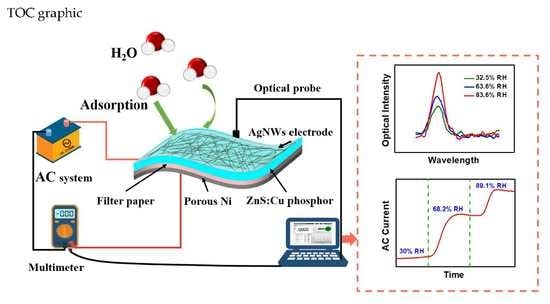Paper-Based ZnS:Cu Alternating Current Electroluminescent Devices for Current Humidity Sensors with High–Linearity and Flexibility
Abstract
1. Introduction
2. Experimental
2.1. Materials and Reagents
2.2. Fabrication of Paper-Based ACELs
2.3. Characterization and Measurement
3. Results and Discussion
3.1. Characterizations of Paper-Based ACELs
3.2. Luminescent Properties of Paper-Based ACELs
3.3. Current Humidity Sensors from Paper-Based ACELs
3.4. Humidity Sensing Mechanism for the ACELs
3.5. Bending Properties and Application of the Device
4. Conclusions
Supplementary Materials
Author Contributions
Funding
Acknowledgments
Conflicts of Interest
References
- Liang, J.G.; Wang, C.; Yao, Z.; Liu, M.Q.; Kim, H.K.; Oh, J.M.; Kim, N.Y. Preparation of Ultrasensitive Humidity-Sensing Films by Aerosol Deposition. ACS Appl. Mater. Interfaces 2018, 10, 851–863. [Google Scholar] [CrossRef] [PubMed]
- Zhao, X.; Long, Y.; Yang, T.; Li, J.; Zhu, H. Simultaneous High Sensitivity Sensing of Temperature and Humidity with Graphene Woven Fabrics. ACS Appl. Mater. Interfaces 2017, 9, 30171–30176. [Google Scholar] [CrossRef] [PubMed]
- Yang, T.; Yu, Y.Z.; Zhu, L.S.; Wu, X.; Wang, X.H.; Zhang, J. Fabrication of silver interdigitated electrodes on polyimide films via surface modification and ion-exchange technique and its flexible humidity sensor application. Sens. Actuators B Chem. 2015, 208, 327–333. [Google Scholar] [CrossRef]
- Shimizu, Y.; Okada, H.; Arai, H. Humidity-Sensitive Characteristics of Porous La-Ti-V-0 Glass-Ceramics. J. Am. Ceram. Soc. 1989, 72, 436–440. [Google Scholar] [CrossRef]
- Wang, S.; Chen, Z.; Umar, A.; Wang, Y.; Tian, T.; Shang, Y.; Fan, Y.; Qi, Q.; Xu, D. Supramolecularly Modified Graphene for Ultrafast Responsive and Highly Stable Humidity Sensor. J. Phys. Chem. C 2015, 119, 28640–28647. [Google Scholar] [CrossRef]
- Jiang, K.; Zhao, H.; Dai, J.; Kuang, D.; Fei, T.; Zhang, T. Excellent Humidity Sensor Based on LiCl Loaded Hierarchically Porous Polymeric Microspheres. ACS Appl. Mater. Interfaces 2016, 8, 25529–25534. [Google Scholar] [CrossRef]
- Li, T.; Li, L.; Sun, H.; Xu, Y.; Wang, X.; Luo, H.; Liu, Z.; Zhang, T. Porous Ionic Membrane Based Flexible Humidity Sensor and its Multifunctional Applications. Adv. Sci. 2017, 4, 1600404. [Google Scholar] [CrossRef]
- Zhu, Y.; Chen, J.; Li, H.; Zhu, Y.; Xu, J. Synthesis of mesoporous SnO2–SiO2 composites and their application as quartz crystal microbalance humidity sensor. Sens. Actuators B Chem. 2014, 193, 320–325. [Google Scholar] [CrossRef]
- Zhou, X.; Zhang, J.; Jiang, T.; Wang, X.; Zhu, Z. Humidity detection by nanostructured ZnO: A wireless quartz crystal microbalance investigation. Sens. Actuators A Phys. 2007, 135, 209–214. [Google Scholar] [CrossRef]
- Wang, X.-H.; Ding, Y.-F.; Zhang, J.; Zhu, Z.-Q.; You, S.-Z.; Chen, S.-Q.; Zhu, J. Humidity sensitive properties of ZnO nanotetrapods investigated by a quartz crystal microbalance. Sens. Actuators B Chem. 2006, 115, 421–427. [Google Scholar] [CrossRef]
- Liu, Y.J.; Shi, J.; Zhang, F.; Liang, H.; Xu, J.; Lakhtakia, A.; Fonash, S.J.; Huang, T.J. High-speed optical humidity sensors based on chiral sculptured thin films. Sens. Actuators B Chem. 2011, 156, 593–598. [Google Scholar] [CrossRef] [PubMed]
- Tian, E.; Wang, J.; Zheng, Y.; Song, Y.; Jiang, L.; Zhu, D. Colorful humidity sensitive photonic crystal hydrogel. J. Mater. Chem. 2008, 18, 1116–1122. [Google Scholar] [CrossRef]
- Cai, D.; Tong, T.; Zhang, Z.; Pan, J.; Zhang, L.; Tong, L. Functional Film Coated Optical Micro/nanofibers for High-performance Gas Sensing. IEEE Sens. J. 2019, 19, 9229–9234. [Google Scholar] [CrossRef]
- Yang, J.; Vak, D.; Clark, N.; Subbiah, J.; Wong, W.W.H.; Jones, D.J.; Watkins, S.E.; Wilson, G. Organic photovoltaic modules fabricated by an industrial gravure printing proofer. Sol. Energy Mater. Sol. Cells 2013, 109, 47–55. [Google Scholar] [CrossRef]
- Liao, X.; Zhang, Z.; Liao, Q.; Liang, Q.; Ou, Y.; Xu, M.; Li, M.; Zhang, G.; Zhang, Y. Flexible and printable paper-based strain sensors for wearable and large-area green electronics. Nanoscale 2016, 8, 13025–13032. [Google Scholar] [CrossRef]
- Harrey, P.M.; Ramsey, B.J.; Evans, P.S.A.; Harrison, D.J. Capacitive-type humidity sensors fabricated using the offset lithographic printing process. Sens. Actuators B Chem. 2002, 87, 226–232. [Google Scholar] [CrossRef]
- Han, J.-W.; Kim, B.; Li, J.; Meyyappan, M. Carbon Nanotube Based Humidity Sensor on Cellulose Paper. J. Phys. Chem. C 2012, 116, 22094–22097. [Google Scholar] [CrossRef]
- Kannan, P.K.; Saraswathi, R.; Rayappan, J.B.B. CO2 gas sensing properties of DC reactive magnetron sputtered ZnO thin film. Ceram. Int. 2014, 40, 13115–13122. [Google Scholar] [CrossRef]
- Gimenez, A.J.; Luna-Barcenas, G.; Sanchez, I.C.; Yanez-Limon, J.M. Paper-Based ZnO Oxygen Sensor. IEEE Sens. J. 2015, 15, 1246–1251. [Google Scholar] [CrossRef]
- Niarchos, G.; Dubourg, G.; Afroudakis, G.; Georgopoulos, M.; Tsouti, V.; Makarona, E.; Crnojevic-Bengin, V.; Tsamis, C. Humidity Sensing Properties of Paper Substrates and Their Passivation with ZnO Nanoparticles for Sensor Applications. Sensors 2017, 17, 516. [Google Scholar] [CrossRef]
- Luo, M.; Shao, K.; Long, Z.; Wang, L.; Peng, C.; Ouyang, J.; Na, N. A paper-based plasma-assisted cataluminescence sensor for ethylene detection. Sens. Actuators B Chem. 2017, 240, 132–141. [Google Scholar] [CrossRef]
- Hwang, D.H.; Ahn, J.H.; Hui, K.N.; Hui, K.S.; Son, Y.G. Structural and optical properties of ZnS thin films deposited by RF magnetron sputtering. Nanoscale Res. Lett. 2012, 7, 26. [Google Scholar] [CrossRef] [PubMed]
- Shinde, M.S.; Samanta, S.S.; Sonawane, M.S.; Ahirrao, P.B.; Patil, R.S. Gas Sensing Properties of Nanostructured ZnS Thin Films. J. Nano Adv. Mat. 2015, 3, 99–106. [Google Scholar]
- Jiang, P.; Jie, J.; Yu, Y.; Wang, Z.; Xie, C.; Zhang, X.; Wu, C.; Wang, L.; Zhu, Z.; Luo, L. Aluminium-doped n-type ZnS nanowires as high-performance UV and humidity sensors. J. Mater. Chem. 2012, 22, 6856–6861. [Google Scholar] [CrossRef]
- Üzar, N.; Okur, S.; Arıkan, M.Ç. Investigation of humidity sensing properties of ZnS nanowires synthesized by vapor liquid solid (VLS) technique. Sens. Actuators A Phys. 2011, 167, 188–193. [Google Scholar] [CrossRef]
- Park, J.H.; Lee, S.H.; Kim, J.S.; Kwon, A.K.; Park, H.L.; Han, S.D. White-electroluminescent device with ZnS:Mn, Cu, Cl phosphor. J. Lumin. 2007, 126, 566–570. [Google Scholar] [CrossRef]
- Liang, G.; Hu, H.; Liao, L.; He, Y.; Ye, C. Highly Flexible and Bright Electroluminescent Devices Based on Ag Nanowire Electrodes and Top-Emission Structure. Adv. Electron. Mater. 2017, 3, 1600535. [Google Scholar] [CrossRef]
- Schrage, C.; Kaskel, S. Flexible and transparent SWCNT electrodes for alternating current electroluminescence devices. ACS Appl. Mater. Interfaces 2009, 1, 1640–1644. [Google Scholar] [CrossRef]
- Alonso, E.T.; Karkera, G.; Jones, G.F.; Craciun, M.F.; Russo, S. Homogeneously Bright, Flexible, and Foldable Lighting Devices with Functionalized Graphene Electrodes. ACS Appl. Mater. Interfaces 2016, 8, 16541–16545. [Google Scholar] [CrossRef]
- Kim, J.-Y.; Park, S.H.; Jeong, T.; Bae, M.J.; Song, S.; Lee, J.; Han, I.T.; Jung, D.; Yu, S. Paper as a Substrate for Inorganic Powder Electroluminescence Devices. IEEE Trans. Electron. Devices 2010, 57, 1470–1474. [Google Scholar] [CrossRef]
- Young, R.; Kitai, A.H. Electrical Dependence of ZnS Thin Films Exposed to H2O. J. Electrochem. Soc. 1992, 139, 2673–2677. [Google Scholar] [CrossRef]
- Zhang, L.; Yu, X.; Zhu, P.; Zhou, F.; Li, G.; Sun, R.; Wong, C.-P. Laboratory filter paper as a substrate material for flexible supercapacitors. Sustain. Energy Fuels 2018, 2, 147–154. [Google Scholar] [CrossRef]
- Chen, M.; Xue, S.; Liu, L.; Li, Z.; Wang, H.; Tan, C.; Yang, J.; Hu, X.; Jiang, X.-F.; Cheng, Y.; et al. A highly stable optical humidity sensor. Sens. Actuators B Chem. 2019, 287, 329–337. [Google Scholar] [CrossRef]
- Tsai, F.-S.; Wang, S.-J. Enhanced sensing performance of relative humidity sensors using laterally grown ZnO nanosheets. Sens. Actuators B Chem. 2014, 193, 280–287. [Google Scholar] [CrossRef]
- Zhang, L.; Gu, F.; Lou, J.; Yin, X.; Tong, L. Fast detection of humidity with a subwavelengthdiameter fiber taper coated with gelatin film. Opt. Express 2008, 16, 13349–13353. [Google Scholar] [CrossRef]
- Ratnasamy, P.; Fripiat, J.J. Surface chemistry of sulphides. Trans. Faraday Soc. 1970, 66, 2897–2910. [Google Scholar] [CrossRef]
- Jiang, H.; Shao, T.; Zhang, C.; Li, W.; Yan, P. Experimental Study of Q-V Lissajous Figures in Nanosecond-Pulse Surface Discharges. IEEE Trans. Dielectr. Electr. Insul. 2013, 20, 1101–1111. [Google Scholar] [CrossRef]
- Biganzoli, I.; Barni, R.; Gurioli, A.; Pertile, R.; Riccardi, C. Experimental investigation of Lissajous figure shapes in planar and surface dielectric barrier discharges. J. Phys. Conf. Ser. 2014, 550, 012039. [Google Scholar] [CrossRef]
- Wager, J.F.; Keir, P.D. Electrical characterization of thin-film electroluminescent devices. Ann. Rev. Mater. Sci. 1997, 27, 223–248. [Google Scholar] [CrossRef]
- Chen, Y.S.; Krupka, D.C. Limitation imposed by field clamping on the efficiency of high-field ac electroluminescence in thin films. J. Appl. Phys. 1972, 43, 4089–4096. [Google Scholar] [CrossRef]
- Liu, L.H.; Zabaras, D.; Bennett, L.E.; Aguas, P.; Woonton, B.W. Effects of UV-C, red light and sun light on the carotenoid content and physical qualities of tomatoes during post-harvest storage. Food Chem. 2009, 115, 495–500. [Google Scholar] [CrossRef]
- Charles, F.; Nilprapruck, P.; Roux, D.; Sallanon, H. Visible light as a new tool to maintain fresh-cut lettuce post-harvest quality. Postharvest Biol. Technol. 2018, 135, 51–56. [Google Scholar] [CrossRef]
- Andersson, H.; Manuilskiy, A.; Gao, J.; Lidenmark, C.; Siden, J.; Forsberg, S.; Unander, T.; Nilsson, H.-E. Investigation of Humidity Sensor Effect in Silver Nanoparticle Ink Sensors Printed on Paper. IEEE Sens. J. 2014, 14, 623–628. [Google Scholar] [CrossRef]
- D’Souza, C.; Yuk, H.-G.; Khoo, G.H.; Zhou, W. Application of Light-Emitting Diodes in Food Production, Postharvest Preservation, and Microbiological Food Safety. Comp. Rev. Food Sci. Food Saf. 2015, 14, 719–740. [Google Scholar] [CrossRef]
- Jou, J.H.; Lin, C.C.; Li, T.H.; Li, C.J.; Peng, S.H.; Yang, F.C.; Thomas, K.R.J.; Kumar, D.; Chi, Y.; Hsu, B.D. Plant Growth Absorption Spectrum Mimicking Light Sources. Materials 2015, 8, 5265–5275. [Google Scholar] [CrossRef]
- Park, J.S.; Fujiwara, K. Quality Preservation of Tomato Seedlings Affected by Different Wavelengths of LED-Low Light during Storage. Eur. J. Hort. Sci. 2009, 74, 21–23. [Google Scholar]
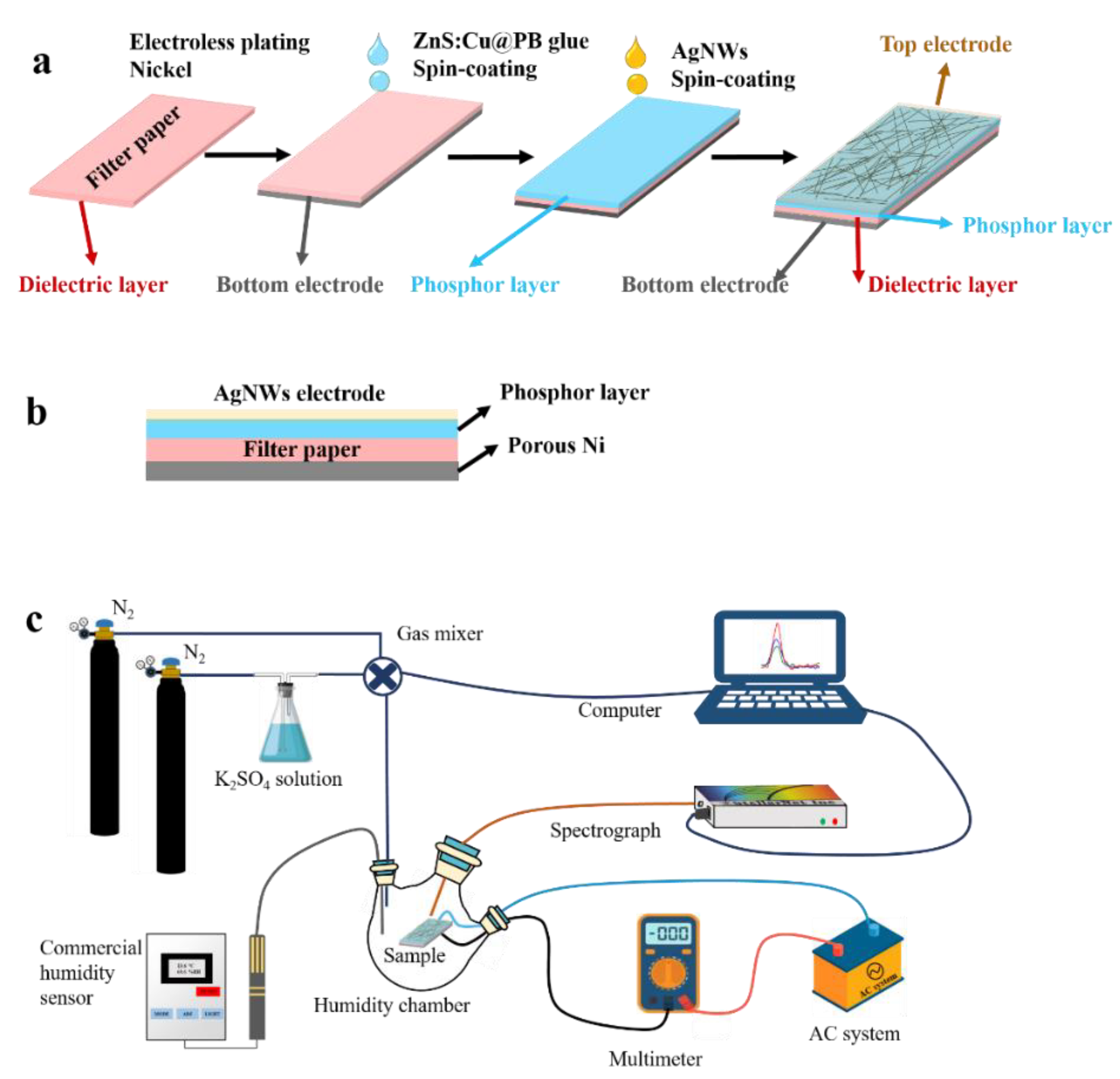
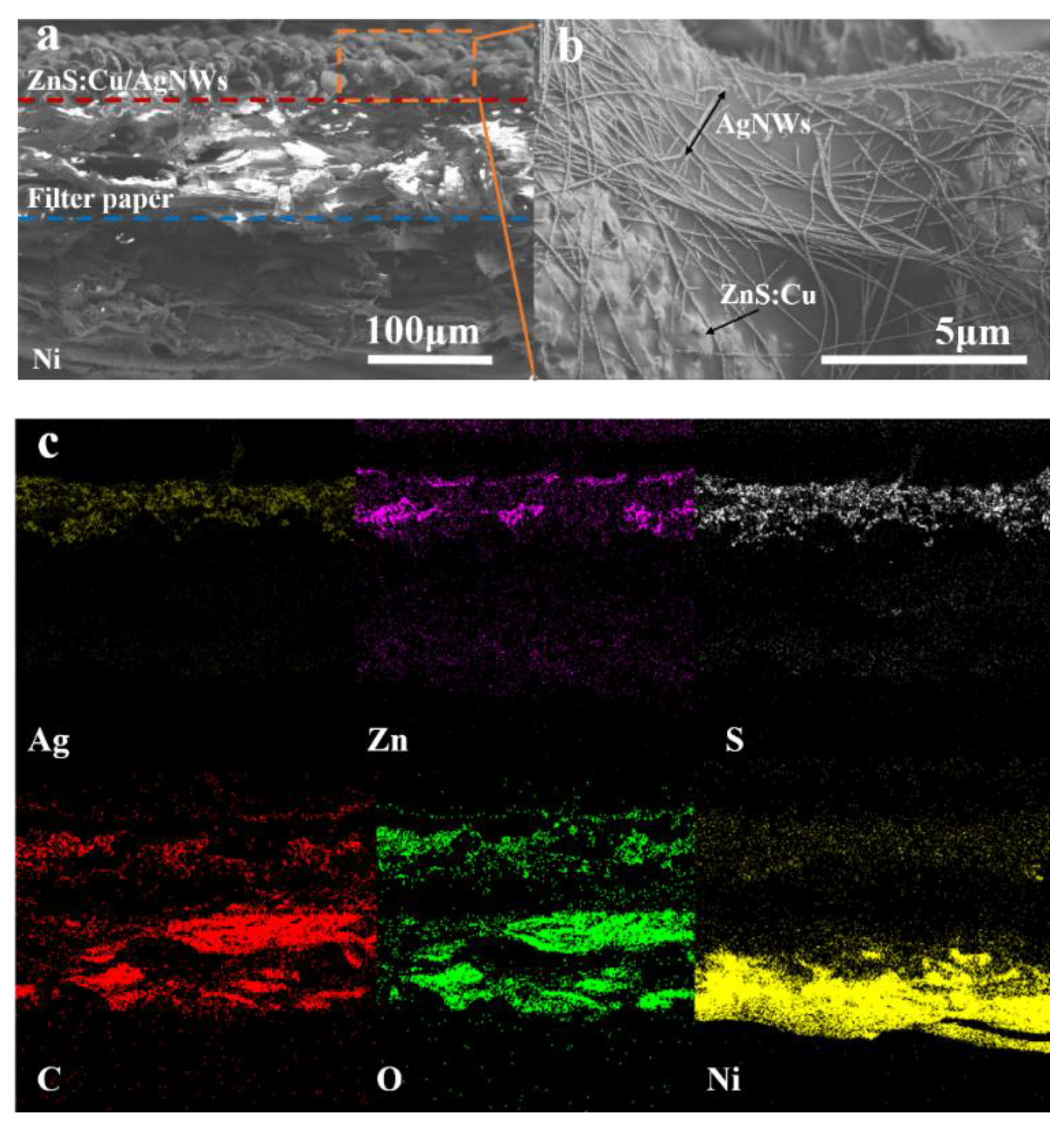
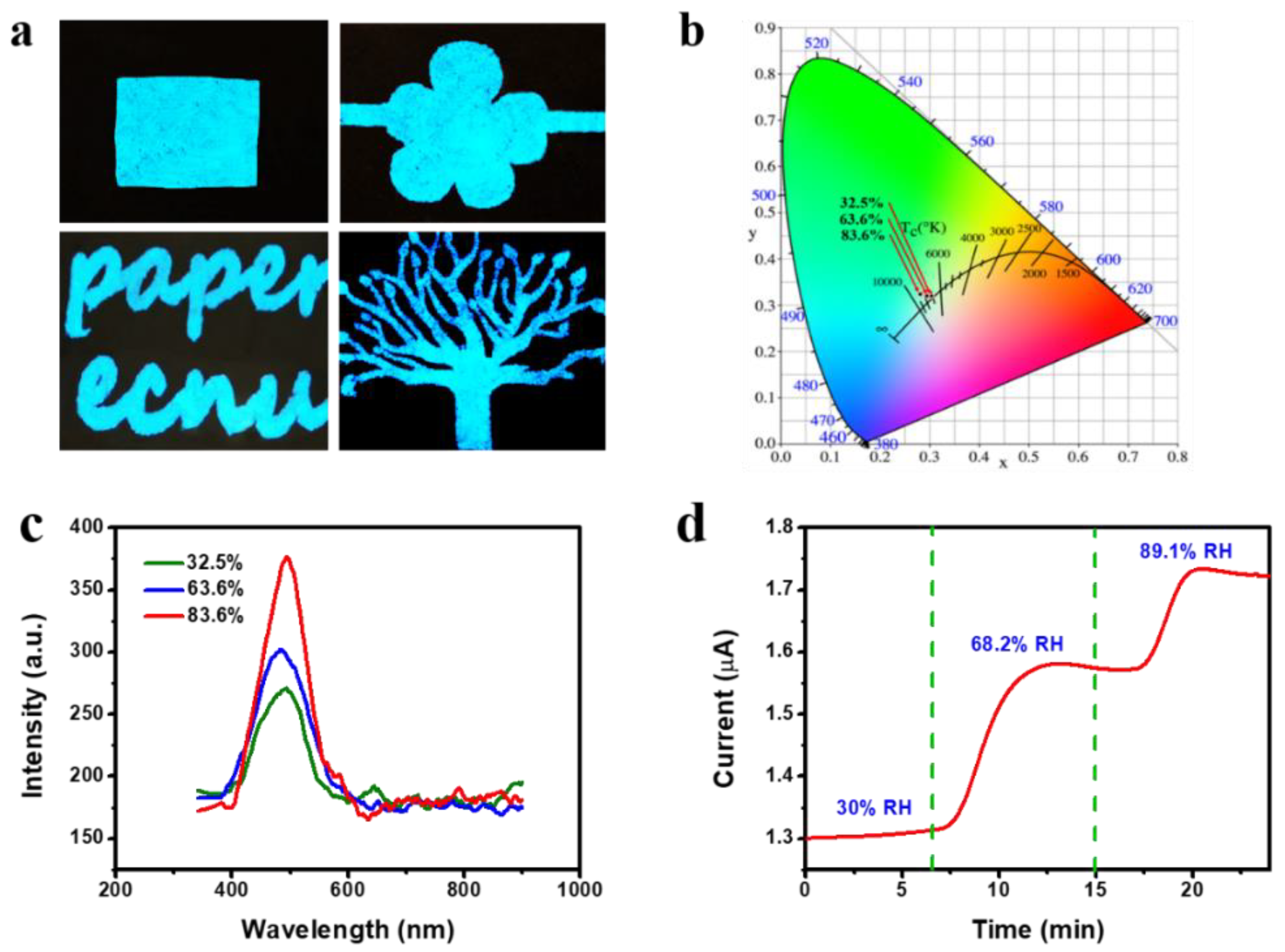
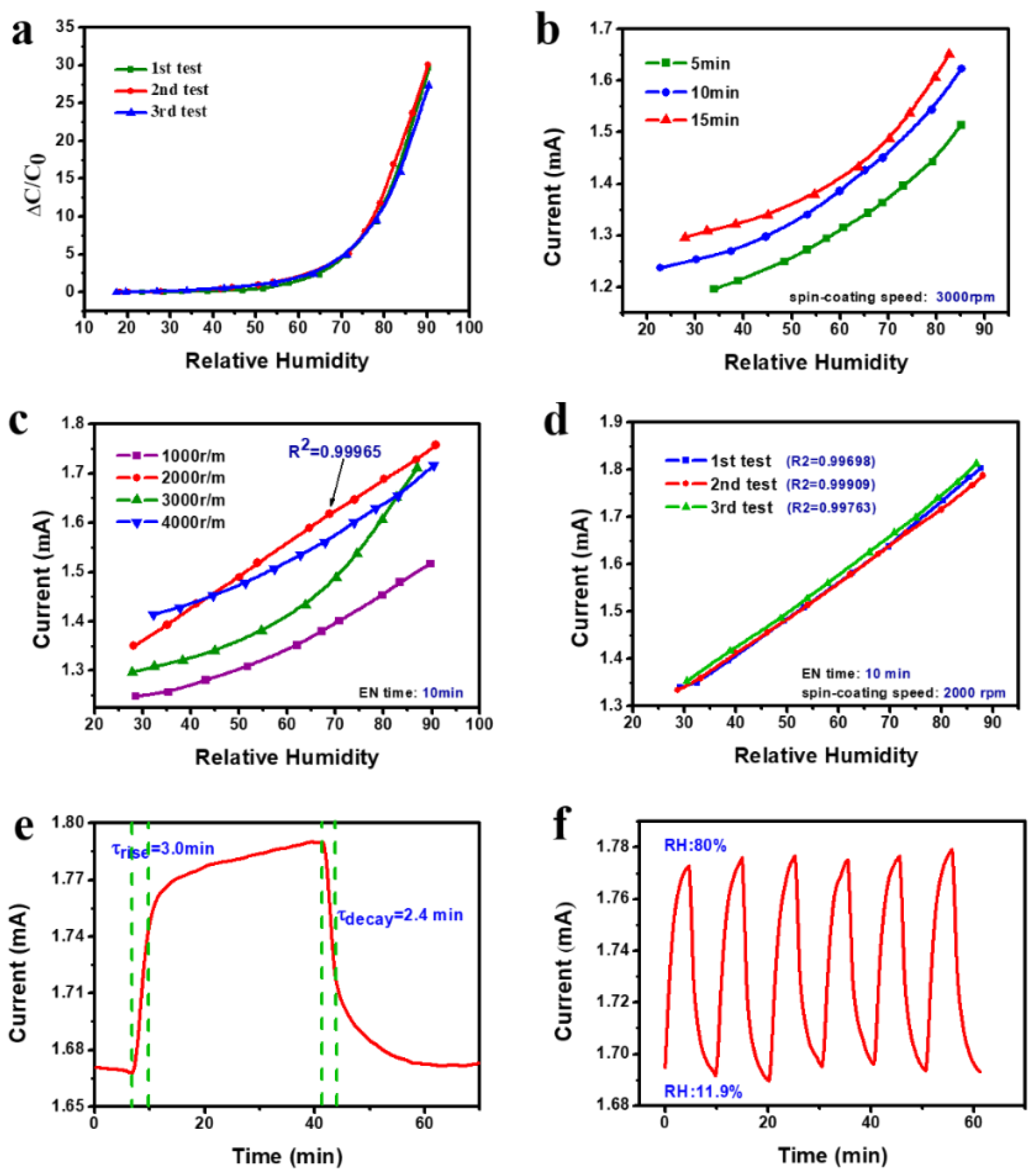
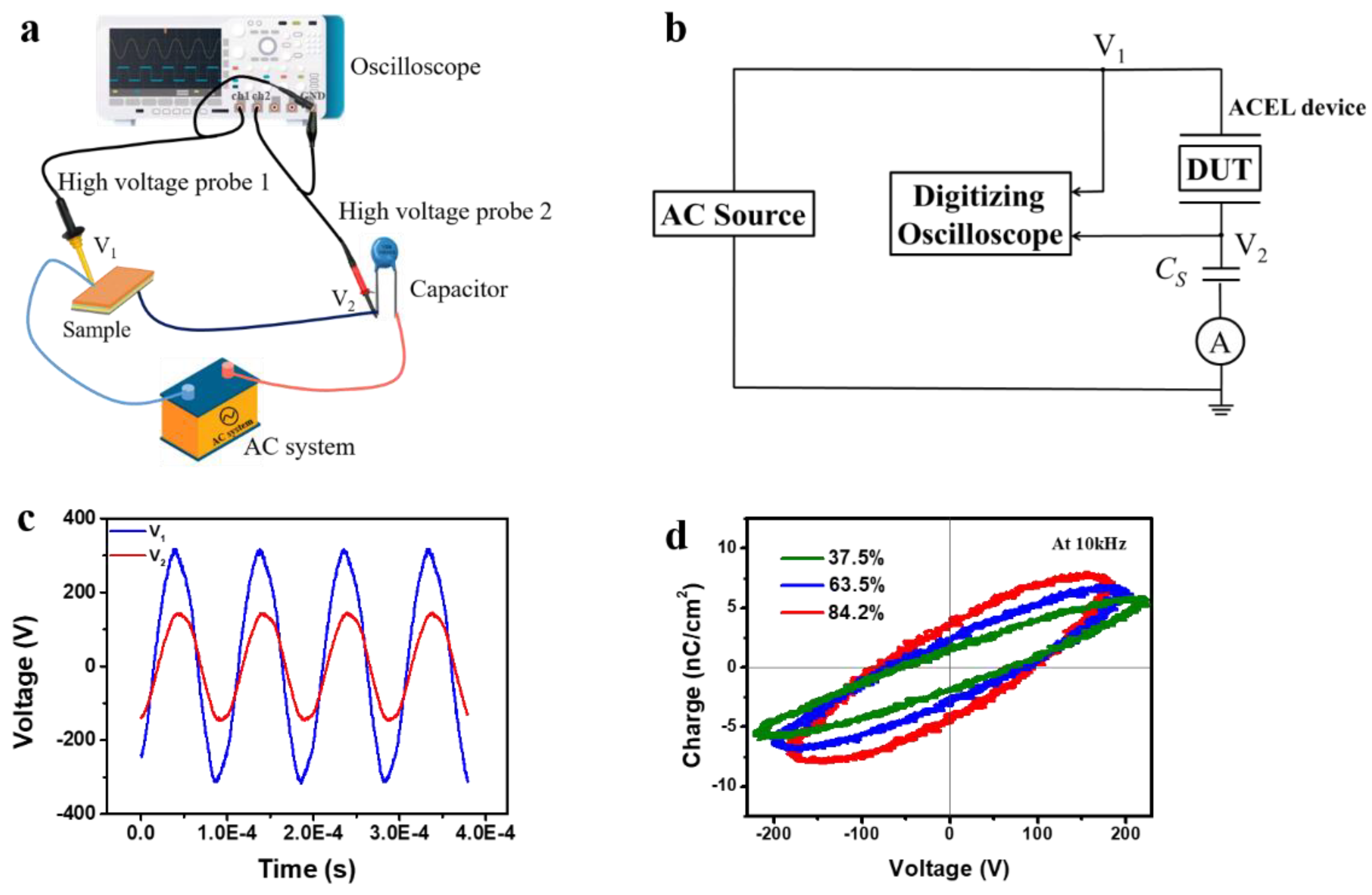
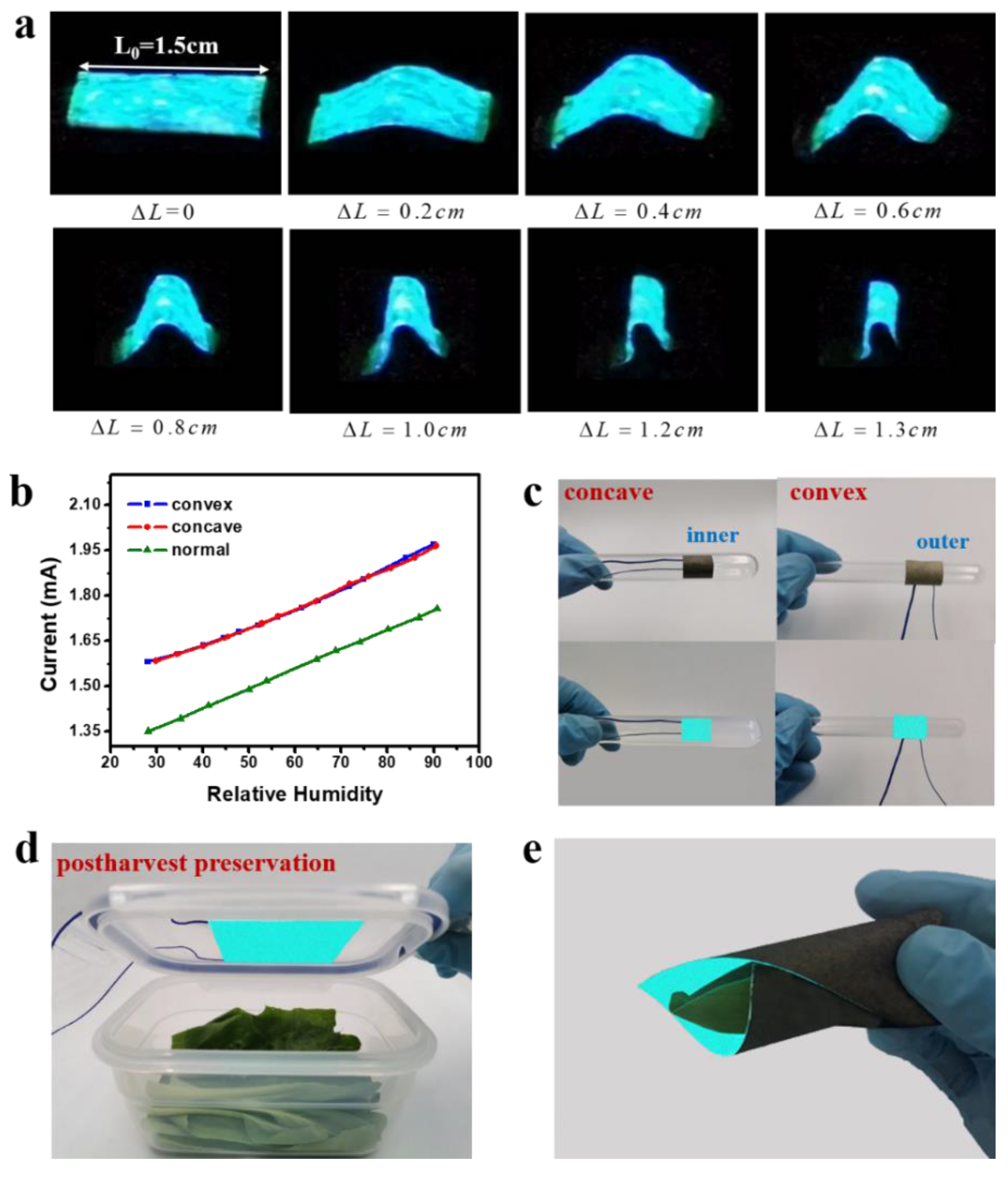
| 37.5 | 0.077 | 0.127 | 0.048 | 7.71 | 1.29 |
| 63.5 | 0.102 | 0.137 | 0.059 | 8.31 | 1.49 |
| 84.2 | 0.143 | 0.142 | 0.071 | 8.62 | 1.71 |
© 2019 by the authors. Licensee MDPI, Basel, Switzerland. This article is an open access article distributed under the terms and conditions of the Creative Commons Attribution (CC BY) license (http://creativecommons.org/licenses/by/4.0/).
Share and Cite
He, Y.; Zhang, M.; Zhang, N.; Zhu, D.; Huang, C.; Kang, L.; Zhou, X.; Hu, M.; Zhang, J. Paper-Based ZnS:Cu Alternating Current Electroluminescent Devices for Current Humidity Sensors with High–Linearity and Flexibility. Sensors 2019, 19, 4607. https://doi.org/10.3390/s19214607
He Y, Zhang M, Zhang N, Zhu D, Huang C, Kang L, Zhou X, Hu M, Zhang J. Paper-Based ZnS:Cu Alternating Current Electroluminescent Devices for Current Humidity Sensors with High–Linearity and Flexibility. Sensors. 2019; 19(21):4607. https://doi.org/10.3390/s19214607
Chicago/Turabian StyleHe, Yaqin, Mengyao Zhang, Nan Zhang, Danrong Zhu, Chun Huang, Ling Kang, Xiaofeng Zhou, Menghan Hu, and Jian Zhang. 2019. "Paper-Based ZnS:Cu Alternating Current Electroluminescent Devices for Current Humidity Sensors with High–Linearity and Flexibility" Sensors 19, no. 21: 4607. https://doi.org/10.3390/s19214607
APA StyleHe, Y., Zhang, M., Zhang, N., Zhu, D., Huang, C., Kang, L., Zhou, X., Hu, M., & Zhang, J. (2019). Paper-Based ZnS:Cu Alternating Current Electroluminescent Devices for Current Humidity Sensors with High–Linearity and Flexibility. Sensors, 19(21), 4607. https://doi.org/10.3390/s19214607




